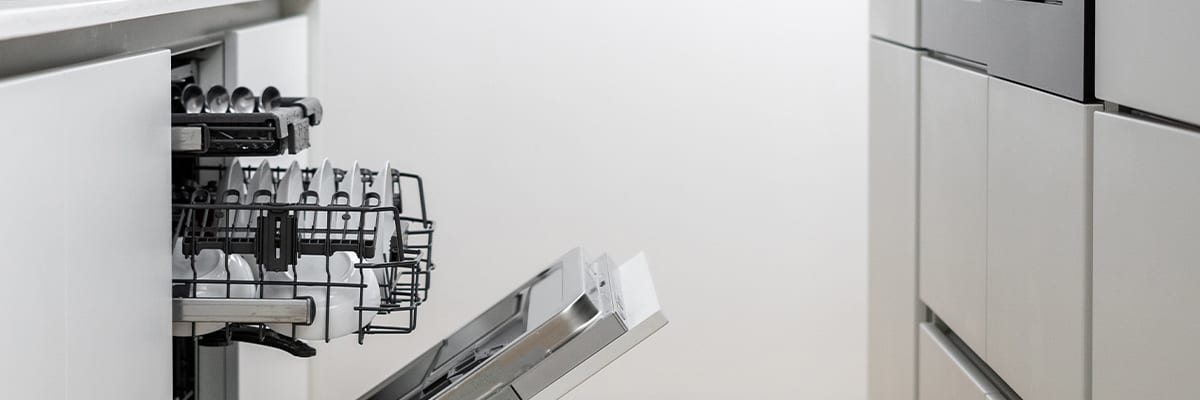
Return navigate_next
How to Clean a Dishwasher
August 12, 2022 *
Given a dishwasher’s job is to clean dishes, not everyone thinks to clean a dishwasher. But as Good Housekeeping explains, “over time, bits of food, grease, undissolved detergent, and water minerals build up on the dishwasher’s filter and interior walls. Along with an unpleasant smell and look, this gunk can actually leave spots and film on your glassware, dinnerware, and flatware.”
Here’s how to clean a dishwasher step-by-step to keep it running at peak performance and your dishes sparkling.
Items You’ll Need to Clean a Dishwasher
- Toothbrush
- Microfiber cloths
- Dish soap or stainless steel cleaning product (depending on your dishwasher’s material)
- Distilled white vinegar
- Baking soda

1. Clean the Dishwasher Exterior
There are a few ways to tackle the process, but we suggest first cleaning the exterior door and control buttons. If you have a plastic or metal door, you can simply dip a microfiber cloth in dish soap and wipe it down. If you have a stainless steel door, you’ll want to use a stainless steel dishwasher cleaner.
Once you’re done, wipe it down with a separate cloth dipped in water. Then buff it dry using a dry cloth. You can clean control buttons by dipping a toothbrush into a mixture of water and dish soap and gently scrubbing around the buttons to remove residue. Then wipe it down with a wet cloth.
2. Remove Racks, Utensils Holder, and Filter
This step serves two purposes. First, it allows you to separately wash the racks, utensils holder, and filter which makes for easier cleaning. Second, it lets you get into all your dishwasher’s nooks and crannies.
Most racks and utensils holders can simply be pulled out. Filters, on the other hand, will either twist off or can be removed by unscrewing them. Once removed, you should soak them in a mixture of warm water and white distilled vinegar for 30 minutes.
While those are soaking, use a vinegar-soaked toothbrush to clean out debris and grime from all crevices, including the spray arms, filter area, and soap dispenser.

3. Run a Dishwasher Cycle with Distilled White Vinegar
Now comes the easy part. Simply pour one cup of vinegar into a dishwasher-safe bowl and place it at the bottom of your dishwasher. Then set it to run on a hot water cycle.
This will flush out most of the remaining debris and residue.
4. Run Another Dishwasher Cycle with Baking Soda
After the first hot water cycle with vinegar is done, sprinkle one cup of baking soda around the bottom of the dishwasher and run another short cycle. This is the ultimate one-two punch that, when combined with the vinegar, will make your dishwasher squeaky clean.
How Often Should You Clean a Dishwasher?
It’s recommended to perform a deep cleaning like this once every six months. This should prevent serious grime and food particles from accumulating and make your dishwasher more hygienic.
Also, note that some dishwashers have a self-cleaning sanitize cycle feature. If yours has one, you should run this once a month for fully optimized performance. This is a simple way to kill nearly all the bacteria left behind during a regular wash cycle. And, in many cases, it can extend the lifetime of your dishwasher, which brings us to our last point.

Protecting Your Dishwasher with an Extended Warranty
As of 2022, the average dishwasher cost $970 and was expected to last about 10 years. However, a Consumer Reports survey found that this didn’t always mean 10 trouble-free years. In fact, survey data “with more than 140,000 dishwashers reveals that about 24.5 percent of all dishwashers either broke or stopped working as well as they should have within five years of ownership.”
And with many manufacturer warranties only lasting one year, it’s important to protect your dishwasher long-term. That’s why we suggest getting an extended warranty.
While some people are reluctant to buy an extended warranty from a retailer because of the exorbitant costs, there are far more affordable options. For example, Upsie offers comprehensive coverage that costs up to 70% less than warranty competitors, including in-store offers.
For comparison, a Bosch 300 Series dishwasher that retails for $899 could be protected by Upsie for three years for $98.99, while a similar offer could cost up to $115 from a retailer. And a five-year plan from Upsie cost $154.99, whereas it would cost up to $230 from a retailer.
With Upsie, your appliances gain protection from defects, power failure, drain failure, heating issues, and more. And customers can make unlimited claims up to the purchase price of the appliance. If you’re looking for affordable, comprehensive, and transparent long-term coverage, Upsie is an excellent option.
Learn More About Appliances:
* This article is over 6 months old and may or may not be updated.
